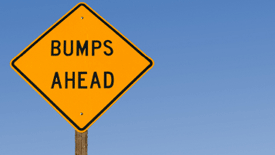Slow Down, Packaging Speed Bumps Ahead
Nov. 19, 2011
Eric Fialkoff
 This month’s blog post starts with a song: “Three cheers for the bus driver, the best of them all!”
This month’s blog post starts with a song: “Three cheers for the bus driver, the best of them all!”
As kids, we would sing this song most loudly when our big orange-yellow kid-carrier would go over a speed bump! We coudn’t wait to be thrown out of our seats, up into the air, and if we were lucky, bump our heads on the top of the bus.
Boy, those were the days, when bumps in the road were actually anticipated with delight.
As the years pass and grey hair begins to pop up (there is a reason I shave my head), bumps in the road are usually met with something other than laughter and smiles. Custom packaging has its own bumps in the road, and I’d like to briefly highlight two of the prominent ones: Chinese New Year and
Over/Under Runs.
Chinese New Year
Every year in Asia, the celebration of Chinese New Year causes a three-week shutdown of factories, and it impacts our customers every year. Already long lead times become much longer if orders are not timed right. In 2012, Chinese New Year will cause a shut down from January 18 to February 7.
Orders for imported goods received by December 1 will be produced and shipped before the shutdown. The estimated time of arrival to the US will be on/around February 15. On the other hand, orders received after December 1 will have an ETA to the United States of around the first or second week in April.
If you rely upon imported products, please consider getting an order in by December 1.
Over/Under Runs
All imported orders and many types of custom packaging require a factory to print the plastic or paper before converting it into a bag or a box. When this is the case, there is always a chance of receiving approximately 15% less product than ordered or 15% more product than ordered, because the factory has to have enough material to meet the requirements of the order and, at the same time, plan on the possibility of defective product.
When a custom run goes poorly, this results in an underrun. Of course, the buyer never has to pay for product that is not received.
However, if the custom run goes smoothly then the result is an overrun. This is where the road gets a little bumpy. Overruns result in more product being shipped than was ordered. The standard tolerance for such an overrun is 15% of the order. In this case, the buyer, when ordering, agrees to purchase an overrun up to 15%. When this possibility exists it is noted on sales quotations.
Please know that overruns (or underruns for that matter) are not intentional. Overruns do not happen so that an extra buck can be made. It is simply the real world of manufacturing. Please do keep the overrun/underrun possibility in mind when placing orders.
Now that we’ve gone over those speed bumps, I will not stop you from breaking out in song: ”Three cheers for the Eric, the best of them all!”